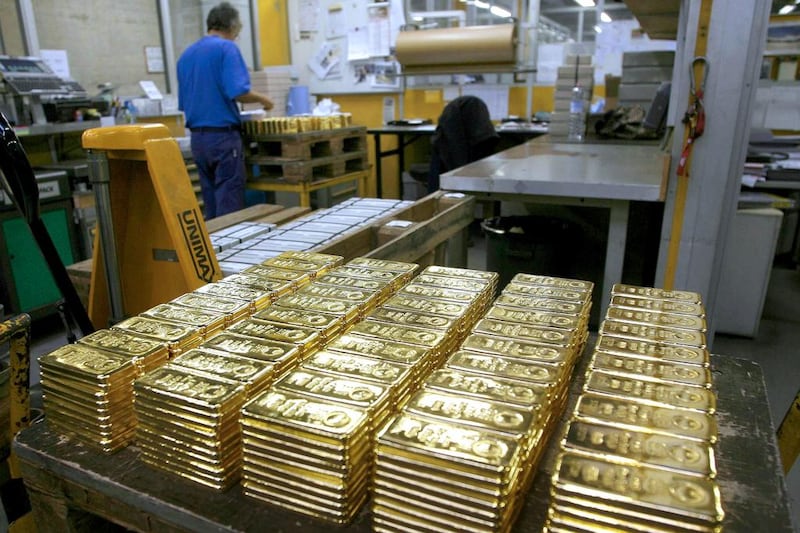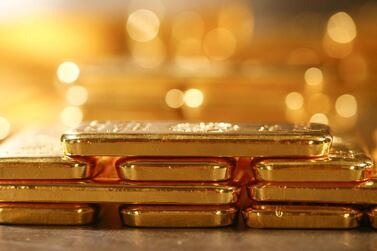Is the multi-week correction of gold that we have seen since the highs of early September now over? Or is there a tidal wave about to disrupt financial markets that will sink all ships, including precious metals?
It could be that both the gold price correction — after the $250 (Dh918) advance over the summer months — is now completed and also that global financial markets are about to face a correction or worse.
But let’s step back a little and examine what has been happening recently.
US stocks hit a new high last week after a 0.25 per cent cut in interest rates by the Federal Reserve. However, market observers pointed to an ominous rotation out of high-flying technology stocks and into defensive sectors like utilities and health.
In short, the market was repricing for lower interest rates and acknowledging a slowdown in profits. That basically says the bull market that was driven by higher profits and share re-ratings is over, and that only the Fed’s manipulation is supporting stock prices.
It’s a very unhealthy sign of a stock market topping out. Richard Branson’s Virgin Galactic fell to earth on its first week trading as a public stock, losing 20 per cent of its $4.5 billion initial valuation. That was also true for more established tech plays like Amazon and Google whose profits disappointed the market.
The dilemma for gold and silver bugs is that in a big downturn in asset prices the good is sucked down with the bad. In the 2008-09 global financial crash, gold and silver lost around 30 and 60 per cent of their value, repetitively, in the initial sell-off.
Admittedly precious metals then rebounded the fastest of any major asset class. But this is not a down-cycle that you would wish to put yourself through again and the big players could well be fighting the last war.
That in my view is why gold has not managed to revisit its summer high of $1,550, ending last week at $1,514. That is a weak performance and suggests gold may not hold on to the gains it has made recently. Technical analysts seem to largely agree with this conclusion and expect a short-term pullback.
Longer-term — and the long-term here can be a matter of weeks or a few months — the majority of analysts who follow precious metals consider the outlook to be exceptionally good, particularly for silver.
Conservatives have gold up $100-$200 an ounce within a year. The more optimistic reckon the yellow metal will pass its old all-time high set in 2011 and trade above $2,000. Few are prepared to forecast prices any higher than that, probably a neat indicator that nobody is getting too carried away just yet.
So why is it that the outlook for gold has turned so bright this year after seven years of being stuck in a $1,050-1,300 trading range?
The most logical explanation is a reaction to three US interest rate cuts by the Federal Reserve Bank and the return of easy money. This reduces the opportunity cost of holding gold. It also makes real interest rates, that is to say interest rates adjusted for inflation, slightly negative.
Why would you hold your money in US dollars, and not gold, if the greenback is being devalued? Investors are always sensitive to losing money. They tend to move away from such asset classes, sometimes quite gradually and then in a rush.
Globally central banks have been buying gold as a diversification away from the US dollar. For investors to follow suit, the massive US bond market itself would have to be facing a crisis. And yet there is always a tipping point in any market where investors rush to the exit.
If you are holding US treasuries paying a derisory coupon that does not even cover you for inflation that is one thing. If suddenly the possibility of a major sell-off and bond price collapse looms, that is another.
Consider the link between the bond and equity markets. Say there is a crash in stocks and the Fed responds — as it usually does — by slashing interest rates. Where does that leave the bond market? Who will want to hold US treasuries after interest rates hit the floor? That would mean bond prices have no higher to go.
This is apocalyptic stuff. But the more fearful of a potential disaster scenario investors become, the more precious metals they will buy and that looks like the long-term trend.
However, this still does not answer the questions posed at the start of this article. Do you now hide in the dollar or precious metals as a safe haven against equity and bond market disruption? Spreading the risk and holding both might be the best solution.
Peter Cooper has been writing about Gulf finance for two decades







